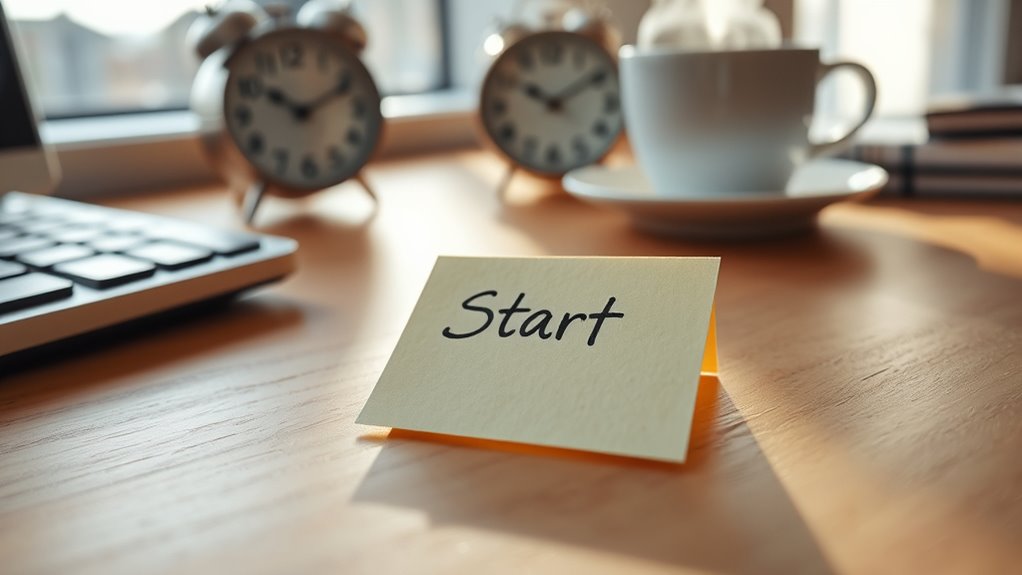Habit Building
Minimum Viable Habits: Starting So Small You Can’t Fail
Great habits start tiny; discover how starting so small can transform your life, but the key to success lies in what comes next.

To start so small you can’t fail, focus on tiny habits that fit seamlessly into your daily routine. Link new actions to habits you already do, like stretching after brushing your teeth. Keep your commitments simple and manageable, like doing one push-up or reading one paragraph. These small steps build confidence and momentum without overwhelm. If you keep going, you’ll discover how these tiny habits can lead to meaningful, lasting change over time.
Key Takeaways
- Focus on tiny, manageable actions that fit seamlessly into daily routines to ensure consistent, failure-proof habits.
- Use habit stacking by linking new habits to existing ones for effortless integration.
- Share small, realistic commitments with accountability partners for motivation and support.
- Prioritize minimal effort habits that can be maintained daily, building confidence over time.
- Start with simple steps that require little time or energy, creating a sustainable foundation for long-term change.

Creating lasting change doesn’t require overhauling your entire life overnight. Instead, it’s about starting small, building momentum one tiny step at a time. The concept of minimum viable habits encourages you to focus on manageable actions that fit seamlessly into your daily routine. When you approach habits this way, failure becomes less likely, and consistency becomes easier. To make this work, consider habit stacking—linking your new habit to an existing routine. For example, if you already brush your teeth every morning, you could add a minute of stretching afterward. This pairing leverages habits you’re already doing, making the new one feel natural and effortless. Over time, these small additions compound into meaningful change without feeling overwhelming.
Accountability partners can also play a pivotal role in maintaining your minimum viable habits. When someone else is aware of your goals, you’re more likely to stick with them. Your accountability partner can be a friend, family member, or coworker who checks in regularly or simply encourages you from time to time. The key is to keep the commitments small and realistic, so neither of you feels discouraged. For instance, promising to do one push-up a day or read one paragraph each morning is simple enough to sustain. These tiny commitments add up, and as you see progress, your motivation naturally increases. Having someone to share your wins—and setbacks—makes the process less solitary and more motivating.
The beauty of starting with minimum viable habits is that they’re so easy to do, you almost can’t fail. Because these habits are intentionally tiny, they require minimal effort and time, which removes typical barriers like procrastination or feeling overwhelmed. The goal isn’t perfection but consistency. Once these micro-habits become ingrained, you can gradually expand them, adding more complexity or duration over time. This slow, steady approach keeps you from burnout and helps build confidence as you succeed daily. Remember, the focus isn’t on making drastic changes overnight but on creating a sustainable foundation. With habit stacking and accountability partners by your side, you’ll find it far easier to stay committed and see your goals turn into lasting habits.
Frequently Asked Questions
How Do I Choose the Right Habit to Start?
When choosing the right habit, focus on habit selection that aligns with your goals and feels achievable. Consider what motivates you most and use motivation strategies to stay committed. Start with small, specific actions that fit easily into your daily routine. This approach helps you build consistency and confidence, making it easier to stick with your new habit over time. Remember, choosing habits you genuinely care about boosts motivation and long-term success.
Can Small Habits Lead to Big Changes Over Time?
Yes, small habits can lead to big changes over time. When you use habit stacking, you link new habits to existing routines, making them easier to maintain. Additionally, accountability partners keep you motivated and on track. Over days, weeks, and months, these tiny actions compound, transforming your life little by little. Consistency and support turn small steps into powerful, lasting progress.
What if I Forget to Do My Tiny Habit?
If you forget to do your tiny habit, don’t worry. Habit tracking can help you stay accountable by reminding you and showing your progress. You might also consider accountability partners who check in with you regularly. When you skip a day, simply get back on track without guilt. Consistency matters more than perfection, and these tools support your commitment to building small, lasting habits over time.
How Long Does It Take to See Results?
You might wonder how long it takes to see results from your habits. It varies, but habit tracking helps you stay consistent and notice progress sooner. Motivation boosts come from small wins, so don’t get discouraged if results aren’t immediate. Keep practicing your habit daily, even if you forget sometimes. Over time, those tiny efforts add up, leading to meaningful change and visible results.
Can Minimum Viable Habits Help Overcome Procrastination?
Imagine you’re in the Renaissance, seeking new ways to conquer procrastination. Minimum viable habits can definitely help. By habit stacking, you create simple, manageable routines that build momentum. Pairing this with accountability partners keeps you motivated and on track. These tiny steps make tasks less intimidating, helping you break the cycle of delay. Over time, you’ll notice increased productivity and confidence, turning procrastination into action, one small step at a time.
Conclusion
Remember, building habits is like planting tiny seeds—you don’t need a forest overnight. Start so small that failure isn’t an option, and watch those tiny actions grow into mighty changes. When you focus on just the bare minimum, you remove the weight of perfection and make progress feel effortless. Keep watering your habits daily, and soon, they’ll blossom into the life you’ve been dreaming of. Tiny roots today, towering trees tomorrow.
Habit Building
Breaking Bad Habits: Substitution Strategies That Stick
I can help you uncover effective substitution strategies to break bad habits and create lasting change. Keep reading to discover how.

To effectively break bad habits, focus on identifying environmental cues that trigger your automatic behaviors. Practice mindfulness to notice these triggers before acting on them, creating space to make conscious choices. Modify your surroundings by removing or replacing tempting cues, which makes old habits less accessible. Staying present during vulnerable moments helps you choose healthier alternatives. With patience and consistent awareness, you can gradually replace unwanted behaviors, and discovering more strategies can further support your journey.
Key Takeaways
- Identify specific environmental cues triggering your bad habits and modify your surroundings to reduce exposure.
- Practice mindful awareness during vulnerable moments to pause and choose healthier alternatives intentionally.
- Replace unhealthy habits with positive behaviors, making substitutions easier through environmental adjustments.
- Develop consistent routines that incorporate mindfulness, helping to gradually break automatic behaviors.
- Be patient and persistent, understanding that lasting change involves small, sustained habit substitutions over time.

Have you ever wondered why breaking a bad habit feels so challenging? It often comes down to the power of environmental cues and how they trigger automatic behaviors. These cues are the subtle signals in your surroundings that prompt you to act without much thought. For example, seeing a pack of cigarettes or reaching for your phone can set off a chain reaction, making it hard to resist the old behavior. That’s where mindful awareness becomes a game-changer. When you develop a conscious understanding of these cues, you start to notice the triggers before they lead you down the familiar, unwanted path. Instead of reacting automatically, you become more intentional about your choices. This heightened awareness allows you to pause and evaluate whether you truly want to follow through or if there’s a better response.
The key is to identify the specific environmental cues that set off your bad habits. Maybe it’s stress that makes you reach for junk food, or boredom that compels you to surf social media endlessly. Once you recognize these signals, you can begin to modify your environment to reduce their influence. For instance, if you tend to snack mindlessly while watching TV, try removing unhealthy foods from your view or replacing them with healthier options. By adjusting your surroundings, you create a space that supports your goal of breaking the habit. This doesn’t mean completely overhauling your environment overnight but making small, strategic changes that make the undesirable behavior less convenient or appealing. Recognizing the role of environmental cues can significantly improve your chances of success.
Practicing mindful awareness also involves staying present during moments when you’re most vulnerable to old patterns. Instead of mindlessly grabbing your phone or reaching for that snack, take a moment to check in with yourself. Ask, “Am I doing this out of habit, or do I really need to?” This simple pause can interrupt automatic responses and give you the opportunity to choose a different action. Over time, this practice strengthens your ability to control impulses and creates new, healthier habits. Remember, it’s not about perfection but consistency. The more you tune into your environment and your internal cues, the easier it becomes to substitute a positive behavior that aligns with your goals. With patience and mindful awareness, you’ll find that breaking bad habits becomes a lot more manageable.
Frequently Asked Questions
How Long Does It Typically Take to Break a Bad Habit?
You might wonder how long it takes to break a bad habit. Habit formation varies, but research suggests it can take anywhere from 21 to 66 days to replace a behavior, depending on your consistency and the complexity of the habit. You need to identify behavioral triggers that prompt your bad habits and actively work to change them. Staying committed and mindful of triggers helps speed up the process.
Can Substitution Strategies Work for All Types of Habits?
Did you know that substitution strategies can sometimes surprise you? They work well for many habits, but habit customization is key—what works for one person may not for another. While substitution can help break some habits, there are limitations, especially with deeply ingrained behaviors. You need to adapt techniques to fit your unique habits, understanding that substitution isn’t a universal fix, but it often offers a promising starting point.
What if I Relapse After Successfully Replacing a Habit?
If you relapse after successfully replacing a habit, don’t get discouraged. It’s normal to face setbacks, so focus on relapse prevention by identifying emotional triggers that led to the slip. Reflect on what caused it, learn from the experience, and adjust your strategies accordingly. Remember, progress isn’t linear, and persistence is key. Keep trying, stay aware of your triggers, and you’ll strengthen your new habits over time.
How Do I Stay Motivated During the Habit-Breaking Process?
Imagine your motivation is a rocket soaring to the moon—you need fuel to keep it going. To stay motivated, set up reward systems that celebrate small wins and keep your spirits high. Find accountability partners who cheer you on and hold you responsible. These tools turn the habit-breaking journey into an exciting adventure, making it easier to stay committed even when your energy dips.
Are There Specific Habits That Are Harder to Change Than Others?
Some habits are harder to change because emotional triggers and environmental cues strongly reinforce them. When you’re faced with stress, boredom, or specific settings, these cues make it tough to break the cycle. You might find that habits linked to emotional states or consistent environments require more effort and targeted strategies. Recognizing these challenging triggers helps you develop effective substitution techniques, making the change process smoother and more sustainable.
Conclusion
Remember, breaking bad habits is like planting a new seed in a barren garden. With patience and the right substitution strategy, you nurture growth where once there was only emptiness. Each small victory is a drop of water, fueling your transformation. Over time, your efforts turn the barren soil into a thriving oasis—your new, healthier self. Keep tending to your garden, and watch your habits bloom into a vibrant landscape of change.
Habit Building
Accountability Partnerships: Making Peer Pressure Positive
Growing your goals with accountability partnerships transforms peer pressure into a motivating force—discover how to harness this power effectively.

Accountability partnerships turn peer pressure into a positive force by creating shared responsibility, motivation, and support. Through regular check-ins, honest feedback, and celebrating small wins, you stay focused and driven toward your goals. These partnerships help you track progress clearly and turn big ambitions into actionable steps. As a result, peer pressure becomes an encouraging force that keeps you committed and resilient—if you’re interested in harnessing this power, there’s more to discover below.
Key Takeaways
- Frame peer pressure as mutual encouragement to foster responsibility and shared growth.
- Set clear, measurable goals with your partner to turn peer expectations into positive motivation.
- Regularly check in and provide honest feedback to maintain accountability and reinforce progress.
- Celebrate small wins together to boost confidence and sustain enthusiasm for goals.
- Cultivate a supportive environment that emphasizes constructive support over criticism to make peer pressure beneficial.

Have you ever wondered how accountability partnerships can boost your personal or professional growth? When you team up with someone who holds you accountable, you tap into powerful motivational strategies that keep you focused and driven. These partnerships aren’t just about checking in; they’re about creating a system of encouragement and responsibility that pushes you toward your goals. One of the key ways they do this is through effective goal tracking. When you share your objectives with a partner, you’re more likely to stay committed because someone else is invested in your progress. This shared accountability turns your aspirations into tangible milestones, making your journey less intimidating and more achievable.
Motivational strategies within accountability partnerships work by strengthening your commitment through regular check-ins and honest feedback. Knowing that your partner is expecting updates keeps you motivated even on days when your enthusiasm wanes. They can help you celebrate small wins, which fuels your momentum and reinforces your belief that your goals are within reach. Conversely, if you start to drift or lose focus, your partner can gently remind you of your “why,” reigniting your determination. This mutual motivation transforms what might feel like a solo struggle into a collaborative effort, where both of you push each other to excel.
Goal tracking is fundamental in this dynamic because it provides clarity and measurable progress. When you set specific, actionable goals and regularly review them with your partner, you create a clear roadmap. This not only helps you recognize accomplishments but also identify any obstacles early on, so you can address them proactively. Your accountability partner acts as a mirror, reflecting your progress and keeping your objectives front and center. This ongoing tracking turns abstract ambitions into concrete steps, making your growth tangible and manageable. Additionally, understanding the importance of contrast ratio can help ensure your visual content remains clear and impactful, especially in darker scenes or environments.
Additionally, accountability partnerships foster a sense of shared responsibility that makes peer pressure work positively. Instead of feeling judged or criticized, you experience encouragement and constructive support. Your partner’s genuine interest in your success creates a safe space where you’re motivated to follow through, knowing someone genuinely cares about your development. This positive peer pressure becomes a catalyst for consistent effort, transforming external expectations into internal drive. Over time, this not only helps you reach your goals but also builds discipline, confidence, and resilience that carry over into other areas of your life.
In essence, accountability partnerships harness motivational strategies and goal tracking to turn your ambitions into achievements. They transform the often formidable path of self-improvement into an engaging and supportive journey, where peer pressure becomes a force for good—driving you forward rather than holding you back.
Frequently Asked Questions
How Do I Find the Right Accountability Partner?
Finding the right accountability partner starts with trust building and goal alignment. You should seek someone who genuinely understands your aspirations and shares similar values. Look for a person who communicates openly and reliably, so you can build a strong foundation. Trust is essential for honest feedback, while aligned goals keep you motivated. By choosing someone who supports your growth, you’ll turn peer pressure into a positive, empowering force.
What if My Partner Isn’t Committed?
If your partner isn’t committed, it can be frustrating. You need mutual motivation and consistent commitment to make accountability work. Talk openly about your goals and expectations, and see if they’re willing to improve their dedication. If they’re still not committed, consider finding someone who shares your motivation and values. Remember, accountability thrives on shared effort and consistency, so partner with someone who genuinely supports your growth.
How Often Should Accountability Meetings Occur?
You might wonder how often you should hold accountability meetings. The key is to find a consistent meeting frequency that works for both of you, creating a reliable accountability schedule. Typically, weekly or bi-weekly meetings work well, providing enough time to review progress without losing momentum. Adjust the meeting frequency as needed to stay motivated and guarantee your accountability partnership remains effective and supportive.
Can Accountability Partnerships Work Remotely?
Yes, accountability partnerships can work remotely. With virtual collaboration, you can stay connected through video calls, messaging apps, or shared accountability tools. Regular check-ins help maintain motivation and focus, even from afar. Using these tools, you can set goals, track progress, and support each other effectively. As long as you prioritize communication and stay committed, remote accountability partnerships can be just as successful as in-person ones.
What Are Signs of a Successful Accountability Partnership?
Imagine a sturdy bridge, strong and reliable. Signs of a successful accountability partnership are like well-placed stones—trust building is evident when both of you openly share and support each other. Goal alignment shines through when your efforts move in harmony, like synchronized dancers. You communicate consistently, celebrate wins, and handle setbacks with understanding. When these elements flow smoothly, your partnership becomes a resilient bridge, guiding you both toward your shared goals.
Conclusion
By embracing accountability partnerships, you turn peer pressure into a powerful force for good. You motivate yourself, support others, and build a community of growth. You set goals, stay committed, and celebrate progress together. You face challenges head-on, learn from setbacks, and keep moving forward. You create a cycle of encouragement, trust, and accountability. In doing so, you transform peer pressure from a potential obstacle into a catalyst for positive change.
Habit Building
Habit Stacking Recipes for Morning Energy
Create habit stacking recipes for morning energy that effortlessly boost your day—discover simple pairings that make waking up energized easier than ever.

To create habit stacking recipes for morning energy, link small actions to your existing routines. For example, after brushing your teeth, do quick stretches or drink a glass of water. Prep your breakfast right after your nighttime routine or open blinds as soon as you wake up. These simple pairings make developing energizing habits easier and more automatic over time. Keep exploring, and you’ll discover even more ways to energize your mornings effortlessly.
Key Takeaways
- Link a glass of water to your morning teeth brushing to hydrate and boost alertness instantly.
- Combine a quick stretching routine with opening blinds to energize your body as you wake up.
- Prepare a healthy breakfast or smoothie the night before, stacking it after your evening wind-down.
- Attach a gratitude or affirmation practice to your morning routine to start with positive energy.
- Incorporate light movement, like jumping jacks or yoga, immediately after waking to increase circulation and vitality.

Habit stacking recipes are a simple yet powerful way to build new routines by attaching them to existing habits. When you combine small, manageable actions with your current daily activities, you make it easier to create lasting change. If you want more morning energy, this approach can help you develop effective habits that stick. One way to start is by integrating meal prep ideas into your routine. For example, after you finish your nighttime routine, you can prepare your breakfast or pack your lunch for the next day. This not only saves you time in the morning but also guarantees you’re fueling your body properly, giving you the energy you need to start your day. By linking meal prep with your evening wind-down, you reinforce the habit without adding extra steps. Over time, this simple adjustment becomes second nature, and your mornings become less rushed and more energized.
Another key aspect to waking up refreshed is paying attention to sleep hygiene tips. Sleep is the foundation of morning energy, so you should prioritize habits that improve your sleep quality. You might stack a new habit like dimming the lights an hour before bed with your existing routine of brushing your teeth. This signals your body that it’s time to wind down, making it easier to fall asleep and wake up feeling more rested. Additionally, if you’re trying to establish a consistent wake-up time, you can link it to another morning activity, such as opening your blinds or doing light stretching. These small steps, when linked to habits you already do, can markedly boost your sleep hygiene and, consequently, your morning vitality. Incorporating knowledge about well-being tips can further optimize your routine for better energy and health.
You can also create a morning energy boost by stacking habits that involve movement or hydration. For instance, after you brush your teeth, you could do a quick set of stretches or drink a glass of water. It’s simple, quick, and integrates seamlessly into your existing routine. Over time, these small adjustments compound, helping you feel more alert and ready to tackle the day. The key is to choose habits that reinforce each other and are easy to perform consistently. Whether it’s meal prep ideas that keep your mornings organized or sleep hygiene tips that improve your rest, habit stacking makes it easier to develop routines that energize you each morning. With intentionality and consistency, these small changes can lead to big improvements in how you start your day.
Frequently Asked Questions
Can Habit Stacking Improve Overall Daily Productivity?
Habit stacking can definitely boost your overall daily productivity by reinforcing habit formation and improving energy management. When you link new habits to existing routines, you create seamless shifts that make behaviors stick. This streamlined approach reduces decision fatigue and helps you stay focused throughout the day. As a result, you’ll find it easier to build positive habits, maintain high energy levels, and accomplish more with less effort, leading to greater productivity.
How Long Does It Take to See Results From Habit Stacking?
Think of habit stacking as planting a seed; it takes a little time to see it bloom. Usually, you’ll notice small changes within a few weeks, but true results often appear after about 30 to 60 days. Staying consistent with your habit helps keep motivation alive and guarantees steady progress. Remember, patience and persistence are your best friends in this journey toward better routines and increased energy.
What if I Miss a Morning Habit—Should I Restart?
If you miss a morning habit, don’t stress. Missing opportunities to stick to your routine is normal, and you don’t need to restart everything. Instead, focus on habit flexibility—adjust your schedule or combine missed habits later in the day. Consistency matters, but setbacks happen. Keep moving forward, learn from missed opportunities, and remember that small adjustments help you stay on track without feeling overwhelmed.
Are Habit Stacking Recipes Suitable for All Age Groups?
You might wonder if habit stacking recipes work for all age groups. The answer is yes, but with some age appropriateness and customization tips. Younger kids may need simpler, short routines, while adults can handle more complex ones. Customize your stacking to suit your energy levels and preferences. Always consider safety and practicality, adjusting the recipes to fit your age and lifestyle for better success and consistency.
How Do I Customize Habit Stacks for Different Goals?
Imagine tailoring a suit versus buying one off the rack. Customization makes all the difference. To customize habit stacks for different goals, use personalization strategies that align routines with your unique needs. Break down goal-specific routines into manageable steps, then anchor new habits to existing ones. This way, you create a seamless, effective system that adapts to your evolving ambitions, ensuring each habit stack works perfectly for your personal success.
Conclusion
Now that you’ve activated these habit stacking recipes, imagine waking up tomorrow feeling unstoppable. The secret to sustained morning energy is within your reach—just one simple change away. But here’s the twist: what if the real transformation begins when you least expect it? Stay committed, and watch how these small shifts create a ripple effect, propelling you into a day filled with clarity and vigor. Your energized mornings are just the beginning—are you ready to discover what’s next?
-

 Wish Notes1 year ago
Wish Notes1 year agoBest Caption to Wish Myself a Happy Birthday That Everyone Will Like!
-

 Wish Notes1 year ago
Wish Notes1 year agoThe Best Birthday Wishes to Make Your Uncle's Day Bright!
-

 Wish Notes1 year ago
Wish Notes1 year agoThe Sweetest Happy Birthday Wishes for Your Wife!
-

 Wish Notes1 year ago
Wish Notes1 year agoThe Best Happy Birthday Wish for Your Brother That Will Make Him Smile!
-

 Wish Notes1 year ago
Wish Notes1 year agoHeartwarming Birthday Messages for Mom in Spanish
-

 Wish Notes1 year ago
Wish Notes1 year agoThe Best Happy Birthday Wishes for Your Husband That Will Make His Day!
-

 Wish Notes1 year ago
Wish Notes1 year agoThe Ultimate Birthday Wishes to Celebrate Yourself!
-

 Wish Notes1 year ago
Wish Notes1 year agoThe Most Heartfelt Good Night Wishes Ever!





















